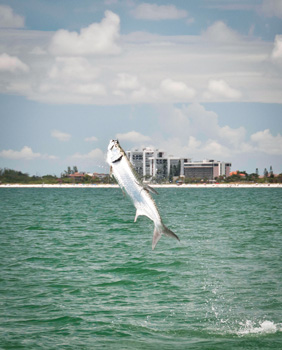Tarpon fishing: show a little respect

Rusty Chinnis | submitted
Tarpon fight hard, make spectacular jumps and
test the stamina of anglers
Tarpon season is in full bloom and should be heading to a peak on the full moon in a couple of weeks. If you've never tried tarpon fishing, don't miss out on what one legendary guide has called "the apex of angling."
The best way to experience this amazing fishery is to engage the services of one of the many excellent guides that call local Gulf waters their office. You don't have to hire a professional to catch a tarpon, but a guided trip will be the best investment you've ever made, guaranteed.
If you decide to try it on your own, here's a quick primer that can get you up to speed. Hooking a tarpon isn't necessarily difficult; in fact it can be quite easy. Catching is another story. First and foremost realize that you'll be throwing bait, lures or flies at one of the most powerful gamefish that swim coastal waters. Not being prepared or aware of what you're doing can be dangerous to you and the tarpon.
First, you need to match your tackle to the task. Unless you plan on just getting a few jumps (not a bad idea) and letting them get away, you'll need a minimum of 20-pound test tackle; 30 is better.
While many anglers seem convinced that you need live bait for any degree of success, I can guarantee you that you can hook tarpon on a well presented artificial lure. I would even recommend trying artificial lures first. It's a lot less hassle to tie on a lure than to deal with live bait.
Here's my recommendation: Start with a quality 30-pound spinning outfit spooled to capacity with the same or heavier line. Double the standing line using a Spider Hitch or a Bimini Twist and tie on a two-foot section of 70-pound fluorocarbon leader.
My favorite lure is a DOA red and white Baitbuster(deep runner trolling model). Another favorite is the 1/2 ounce DOA Nite Glow Shrimp. The hook that comes with the shrimp doesn't leave a very big gap, so try replacing it with an Owner Aki 3/0 or 4/0.
If you have a favorite lure use it, because the most important choice when it comes to any lure is your confidence in it. I haven't found tarpon to be particularly picky as long as it's presented correctly and they're in the mood to feed. One caveat – the hook must be sharp and stout.
Once you're rigged and ready, you need to find the fish. Any given day you'll see boats that are hunting tarpon cruising up and down the beach. Some hardly ever stop. Personally, I like to find an area where tarpon travel, like the edge of a bar, and just wait for them to come to me.
It's OK to move around a bit, but anglers that have patience invariably do better than those who can't sit still. When the water is clear and the sun is out, tarpon are easy to spot. On cloudy days you have to look for fish coming to the surface for a breath of air.
Tarpon are occasionally hooked by anglers that do everything wrong, but that's the exception and not the rule. When you spot schools of moving fish, get well ahead of them, establish their track and cut your outboard at least 50 yards ahead.
If you're casting a lure or a fly, the presentation has to be nearly perfect, moving away from or across their path. Another important factor is getting the presentation down to the tarpon's level. They will seldom go even a foot or two off out of their way to take bait or lure.
Hooking a tarpon is a feat in itself, as they have incredibly hard mouths. You have to have either very sharp hooks, or better yet, circle hooks. The trick with circle hooks is to never set the hook. Just let the line come tight and start reeling.
In either case, when you hook a tarpon, fight it with maximum pressure from the hook set until you have it at the boat. Lots of beginners lose fish by not applying enough pressure, hoping, mostly in vain, that it will keep them from breaking off. My experience is that the longer you fight them, the better chance you have of losing them.
When you go tarpon fishing it's OK to pay attention to other more experienced anglers, but never intrude on a boat that's stalking a school. Circle wide of other anglers and go farther down the beach and line up for a turn. It's rude and ruins the fishing for everyone when you run up on a school of fish after anglers are in position to intercept them.
Tarpon fishing should be fun and not a shouting match. If other anglers ruin your fishing, try explaining the rules to them. In most cases they don't even know what they're doing. Someone who just doesn't care isn't worth the effort, so just go find fish somewhere else. My rule is to show them the courtesy they don't show me!
Tarpon are one of the sport's greatest challenges and a test of your angling mettle. Now is the time to try your hand either on your own or with a guide. Chances are you'll find an ad for one of the area's professional guides on a nearby page. And don't forget to show a little respect. This can and should be fun for everyone.

